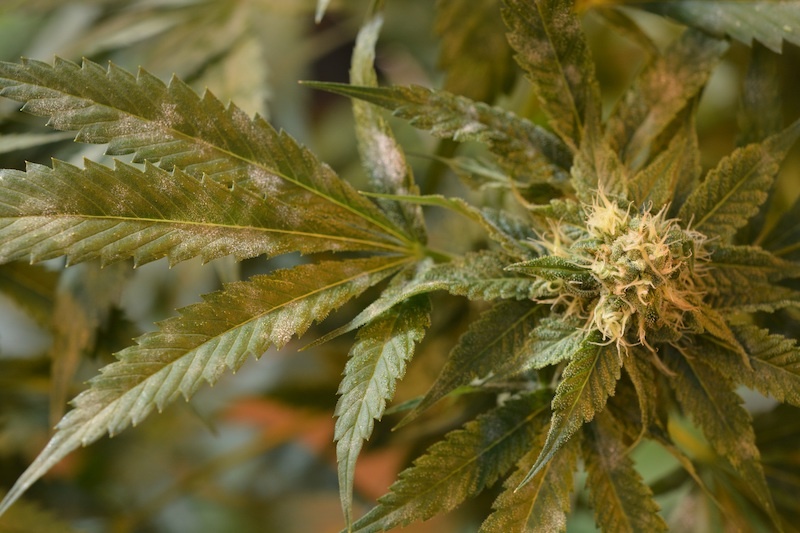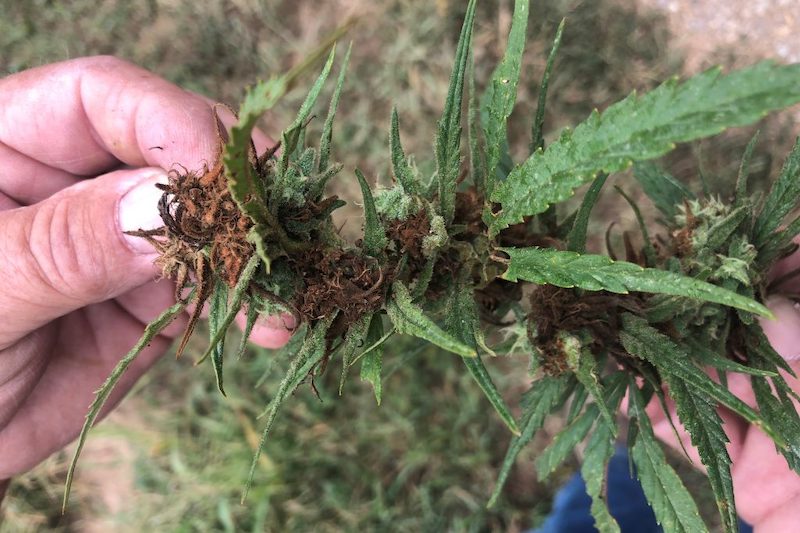
The Big Three Cannabis Diseases
Several factors can affect the production of a healthy cannabis crop — diseases being among the most common and difficult to control once established. GPN recently caught up with Tami Van Gaal and Erica Hernandez, division leader and technical specialist, respectively, at Griffin Greenhouse Supplies, to learn how growers can identify, control and prevent the three most important diseases found in indoor cannabis production: powdery mildew, Botrytis and hops latent viroid.
Powdery mildew and Botrytis are two foliar diseases capable of decimating a crop if left unchecked. Both of these spores are fairly ubiquitous in the environment, making it hard to completely eliminate exposure. Of the two, powdery mildew tends to be harder for growers to control and the biggest reason for that is the disease organism gets into the interior of the leaf.
The signs that we see — the white powdery growth on the exterior of the leaf — is sporulation. By the time that happens, the mycelium are all over the place inside the leaf. Where Botrytis, on the other hand, is penetrating the leaf surface but doesn’t hide within the cells within the leaf. It’s generally penetrating from the outside in.
Botrytis
When it comes to preventing Botrytis, get all of the debris out of the greenhouse and, remove any foliage that isn’t healthy or isn’t going to recover for any reason at all. It could be as simple as everybody brushes up against one side of the bench and those leaves or branches start to get bruised — get them out of there.

Make sure the climate is managed in a way that you don’t have condensation occurring on foliage. The biggest point to watch for is typically right at that point when we change from day to night. So in a warehouse it’s really abrupt. The lights turn off, the HVAC system is compensating and you hit a point where the humidity goes up to where you can actually condensate on the leaves.
“In a greenhouse, it’s also going to generally be because of swift environment change,” Van Gaal. “But it’s less about that exact moment we transition from day to night and it’s more just about increasing humidity in the space over time. Growers should be prepared to vent. If the humidity is too high outside to effectively vent, you actually heat the greenhouse space and that will dry out the air.”
Powdery mildew
Powdery mildew (pictured at top of page) is the more difficult foliar disease to detect early and to control once it has been established in the crop. When spores land on leaves and begin to grow, growers may notice a slightly dull appearance, or slight change in color, as mycelium develop across leaf surface.
The way that cannabis is typically grown can create a high-humidity microclimate around the foliage. With tight spacing and little room for air to get around the plant, you end up with an environment where powdery mildew can thrive.
“Any time your relative humidity and temperature environments are experiencing wide swings, be on the lookout,” says Erica Hernandez, Griffin’s CEA GGSPro Technical Specialist. “Powdery mildew requires both dry leaf surfaces and humid environments to complete its lifecycle, so having fluctuating periods of high relative humidity and low relative humidity puts your crop at risk.”
Both diseases require constant preventive control with great attention to the environment plants are growing in. This includes managing humidity, moisture, the incidence of free moisture on the foliage and temperature.
With a limited arsenal at their disposal, preventative measures are of the utmost importance for cannabis growers. Growers should use preventative sprays, such as biopesticides, whenever allowed to. The regulation of what products can be used varies state-by-state and the rules by state vary widely. Growers need to make sure they are staying on top of what’s allowed in their specific state, stresses Van Gaal. “If you familiarize yourself with the conditions conducive for powdery mildew or botrytis, you can easily detect when your environment meets those parameters and spray ahead of time.”
Hops latent Viroid (HpLVD)
HpLVD is a viroid that is transmitted in a similar way to viruses. The most reliable form of transmission is mechanical transmission, says Hernandez. It is transmitted through contact with diseased plant materials. “If staff have contact with a diseased plant, then healthy plants can be exposed through crop work and trimming. Essentially, any activity that can transfer sap from one plant to another brings risk if proper sanitation is not practiced.”

“The most common way that this is getting into grows is a lot of cannabis producers will share clones,” says Hernandez. “When they’re trying out different genetics, it’s common to get clones from another facility and, unfortunately with hop latent viroid, the latent part in the name really comes into play here because plants can be infected with this viroid and not show any symptoms at all. But they would still be capable of transmitting and propagating this viroid.”
Symptoms tend to show up under times of stress or as the plant gets further into the flowering stage. HpLVD is also responsible for phenomena growers are calling “dudding,” where some plants do not grow as big as genetically identical clones that are all around them. Lower trichome production in these smaller plants will make them look noticeably less frosty. Some growers have reported “Christmas tree branching” as a symptom, Hernandez notes. This causes a 90-degree angle where branches meet the stem rather than an upward angle.

Hernandez recommends the following preventative controls and treatment methods for HpLVD.
Sanitation is vital. Any tool that’s coming into contact with potentially infected plants should be aggressively sterilized. Alcohols should be avoided when working with HpLVD.
“[Alcohols are] actually a really bad idea because it precipitates the viroid and protects it on the surface,” says Hernandez. “You’re not destroying the viroid. You’re just sealing it away for potential future infection.”
Hydrogen peroxide and peroxyacetic acid do have some efficacy but are not as effective as bleach and heat sterilization.
Treat your crop as if every plant was infected. If you have not tested your crop, you must assume that everything is infected, says Hernandez. Treat everything like you’re trying to stop the spread from plant to plant. On-site propagation offers the benefit of being able to control any potential outside factors.
“Starting from seed is one way to manage virus because seed transmission of virus or viroid is really only about 10% with hops latent viroid,” says Hernandez. “If you’re producing seeds from an infected plant, you already know that you’re reducing the virus or viroid load by 90%.”
Outgrow the virus. Growers can take fresh cuttings from an infected plant, root them and try to grow them at a faster rate to get vegetative growth fast. “Then they’ll take very fresh, very young cuttings from the plant and [growers] repeat this process over and over again with the idea that the newest, youngest growth has the lowest viroid load,” says Hernandez.
Growers can either reduce or completely eliminate the viral load through these successive growing and cutting cycles. Hernandez stresses the need to test in order to confirm that the disease has been eradicated from your crop.
“Any management practice, any sort of trying to get your facility to bounce back from hop latent viroid infestation, requires access to reliable testing,” she says.
The most reliable is QPCR (Quantitative polymerase chain reaction) testing, according to Hernandez. Various companies offer this testing as a lab service or are producing QPCR machines for purchase that growers can use on-site. Test strips are a popular testing method with viruses, but at this time viroid testing and HpLVD testing with test strips is not as reliable yet.









